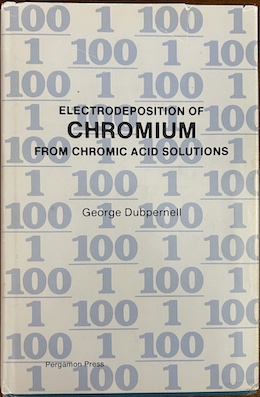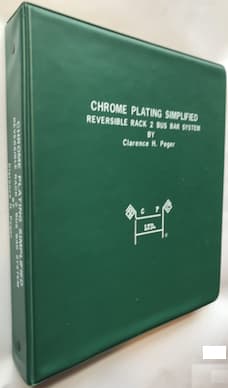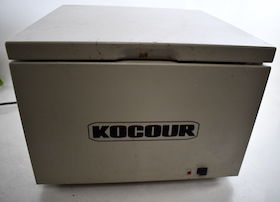
-----
Chrome Bath Help: Chrome to Acid Ratio
The first successful chrome plating solution was chromic acid and sulfuric acid at a 100:1 ratio. Since that time some people have adopted fluoride catalysts or MSA catalysts. If this is new or confusing to you, you might want to start with thread 35184 "FAQ: Chrome Plating Catalysts".
Q. Good morning, I just redid a 5300 lt tank with 27% chromic acid for hard chrome plating. I put CHROMIC ACID SOLUTION 37% 500 g/l Kg. 1250 for 3750 lt. then I added 2000 lt of distilled water to bring it to the level. now how much 96% sulfuric acid do I need to get it going? A chemist told me 8.5 lt while another told me 4.5 lt. Can someone help me understand who is right? thanks
marco- torino italy
October 7, 2024
Readers are welcome to browse this site anonymously!
-- but its main purpose is worldwide camaraderie through sharing,
so readers wanting that might not engage with anonymous posters.
A. Hi Marco.
The rule of thumb for conventional Sergeant's chrome plating baths is 100:1 ratio of chromic acid to sulfate (the molecular weight of sulfate is so close to sulfuric acid that it doesn't really matter much).
I don't quite understand the numbers you are giving us, but if you are saying the chrome or chromic acid is 27% (270 g/l of chromic acid), that would be reasonably conventional ... and it would call for a target of 2.7 g/l of sulfate (or sulfuric acid. We have several threads about this, so search the site for "chromic sulfuric ratio".
But a general approach in stuff like this is to test stuff in the lab and scale up ... why did you "redo" a 5300 liter tank instead of just making adjustments? Thanks.
Luck & Regards,

Ted Mooney, P.E. RET
Striving to live Aloha
finishing.com - Pine Beach, New Jersey
Ted is available for instant help
or longer-term assistance.
A. Marco,
Chrome ratio:
There are two types of ratio
1) hard chrome ratio -- chromic acid to sulfuric acid ratio 100:1
2) decorative chrome ratio == chrome ratio should be 125 to 140 with using catalyst.

Popatbhai B. Patel
electroplating consultant - Roseville, Michigan
Multiple threads merged: please forgive chronology errors and repetition 🙂
Q. I have a Baumé of 28 at room temp. Is this right? Does sulfuric acid raise or lower the Baumé reading.
My chrome is depositing gray. I'm new and have the books coming but I'm excited to see it work.
Please be gentle with me, I want to learn.
new operator - Arkansas
June 10, 2008
|
|
A. Hey there, - Mexico City, Mexico A. Baumé is a poor estimate of the condition of the chrome bath. For good and consistent results, you need to do a titration for the chrome and analyze the sulphate with a precipitation and centrifuge method which is quick easy and reliable. Kocour makes a hand powered centrifuge that is OK, if you maintain a constant and correct RPM. - Navarre, Florida A. Brian, - Great Neck, New York |
for Shops, Specifiers, & Engineers

by Weiner & Walmsley (1980)
avail from eBay, AbeBooks, or Amazon

by Robert K. Guffie (1986)
avail from AbeBooks, or Amazon

avail from eBay, AbeBooks, or Amazon
"Hard chromium plating: A Handbook of Modern Practice"
by John David Greenwood (1971)
avail from eBay

very rarely avail from Amazon
but copies are available in a few libraries)
"A Chromium Plating Bath With The Fluoride Ion"
by Alfred Perlenfein (2013)
avail from eBay, AbeBooks
(as an Amazon Associate & eBay Partner, we earn from qualifying purchases)
? Brian, hello.
Sorry, I got more questions than answers. Apart from chromic acid and sulfuric acid content,
1. What is the operating temperature?
2. What is the current density applied ?
3. What is the plating time?
4. Hard Chrome/Decorative chrome?
5. Substrate ? Chrome applied over Nickel?
- Penang, Malaysia
A. SK,
They are all interdependent for a quality coating. Personally, I would buy two of the recommended books from amazon or whoever has used books in your country. Read them cover to cover before you spend a single rupee on anything else. There is a massive amount of information and sorting it all out is not simple as every plater has a tweak or two on one of the two or three main process methods.
Chrome plating is as much an art as a science, so consider working for a chrome plater for a year before jumping into the business.
- Navarre, Florida
Ed. note: we apologize for causing some confusion; we don't think that SK was asking how to chrome plate, but was asking Brian for his parameters so that he could help with the gray plating problem.
A. Sometimes you'll need more Sulfuric Acid as catalyst. When I started with metal finishing I had the same issue "gray chrome". I tested many ratios and today I rather to use 5:100 instead the most common 1:100.
Sandry Seibert- Campinas, SP, Brazil
![]() Hi, Sandry. That is very interesting; I have never heard of sulphate ratios even half that high!
Hi, Sandry. That is very interesting; I have never heard of sulphate ratios even half that high!
Regards,

Ted Mooney, P.E.
Striving to live Aloha
finishing.com - Pine Beach, New Jersey
Ted is available for instant help
or longer-term assistance.
Q. Hi,
When talking about ratio, are we talking about moles? or grams? or other units? or since it's ratio it's dimensionless?
On the Baumé
reading, is the temperature of the bath when the reading is taken very critical?
Thank you very much.
- Cavite, Philippines
June 9, 2009
A. Hi
It's not dimensionless, you go by mass -- it's grams to grams or ounces to ounces, etc.
Luck & Regards,

Ted Mooney, P.E. RET
Striving to live Aloha
finishing.com - Pine Beach, New Jersey
Ted is available for instant help
or longer-term assistance.
Q, A, or Comment on THIS thread -or- Start a NEW Thread

